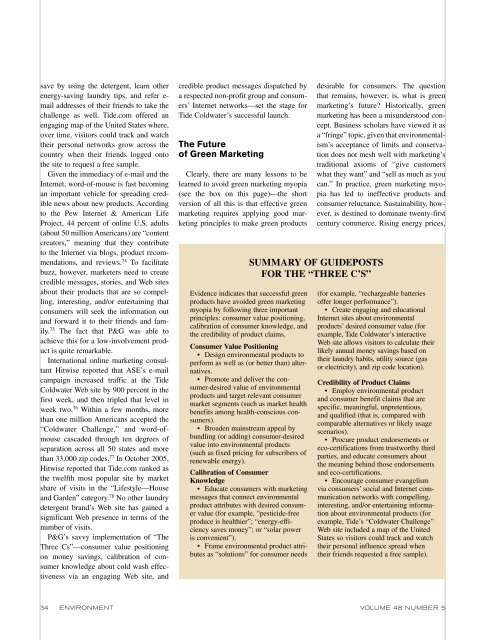Avoiding Green Marketing Myopia - J. Ottman Consulting
Avoiding Green Marketing Myopia - J. Ottman Consulting
Avoiding Green Marketing Myopia - J. Ottman Consulting
Create successful ePaper yourself
Turn your PDF publications into a flip-book with our unique Google optimized e-Paper software.
save by using the detergent, learn other<br />
energy-saving laundry tips, and refer email<br />
addresses of their friends to take the<br />
challenge as well. Tide.com offered an<br />
engaging map of the United States where,<br />
over time, visitors could track and watch<br />
their personal networks grow across the<br />
country when their friends logged onto<br />
the site to request a free sample.<br />
Given the immediacy of e-mail and the<br />
Internet, word-of-mouse is fast becoming<br />
an important vehicle for spreading credible<br />
news about new products. According<br />
to the Pew Internet & American Life<br />
Project, 44 percent of online U.S. adults<br />
(about 50 million Americans) are “content<br />
creators,” meaning that they contribute<br />
to the Internet via blogs, product recommendations,<br />
and reviews. 74 To facilitate<br />
buzz, however, marketers need to create<br />
credible messages, stories, and Web sites<br />
about their products that are so compelling,<br />
interesting, and/or entertaining that<br />
consumers will seek the information out<br />
and forward it to their friends and family.<br />
75 The fact that P&G was able to<br />
achieve this for a low-involvement product<br />
is quite remarkable.<br />
International online marketing consultant<br />
Hitwise reported that ASE’s e-mail<br />
campaign increased traffic at the Tide<br />
Coldwater Web site by 900 percent in the<br />
first week, and then tripled that level in<br />
week two. 76 Within a few months, more<br />
than one million Americans accepted the<br />
“Coldwater Challenge,” and word-ofmouse<br />
cascaded through ten degrees of<br />
separation across all 50 states and more<br />
than 33,000 zip codes. 77 In October 2005,<br />
Hitwise reported that Tide.com ranked as<br />
the twelfth most popular site by market<br />
share of visits in the “Lifestyle—House<br />
and Garden” category. 78 No other laundry<br />
detergent brand’s Web site has gained a<br />
significant Web presence in terms of the<br />
number of visits.<br />
P&G’s savvy implementation of “The<br />
Three Cs”—consumer value positioning<br />
on money savings, calibration of consumer<br />
knowledge about cold wash effectiveness<br />
via an engaging Web site, and<br />
credible product messages dispatched by<br />
a respected non-profit group and consumers’<br />
Internet networks—set the stage for<br />
Tide Coldwater’s successful launch.<br />
The Future<br />
of <strong>Green</strong> <strong>Marketing</strong><br />
Clearly, there are many lessons to be<br />
learned to avoid green marketing myopia<br />
(see the box on this page)—the short<br />
version of all this is that effective green<br />
marketing requires applying good marketing<br />
principles to make green products<br />
Evidence indicates that successful green<br />
products have avoided green marketing<br />
myopia by following three important<br />
principles: consumer value positioning,<br />
calibration of consumer knowledge, and<br />
the credibility of product claims.<br />
Consumer Value Positioning<br />
• Design environmental products to<br />
perform as well as (or better than) alternatives.<br />
• Promote and deliver the consumer-desired<br />
value of environmental<br />
products and target relevant consumer<br />
market segments (such as market health<br />
benefits among health-conscious consumers).<br />
• Broaden mainstream appeal by<br />
bundling (or adding) consumer-desired<br />
value into environmental products<br />
(such as fixed pricing for subscribers of<br />
renewable energy).<br />
Calibration of Consumer<br />
Knowledge<br />
• Educate consumers with marketing<br />
messages that connect environmental<br />
product attributes with desired consumer<br />
value (for example, “pesticide-free<br />
produce is healthier”; “energy-efficiency<br />
saves money”; or “solar power<br />
is convenient”).<br />
• Frame environmental product attributes<br />
as “solutions” for consumer needs<br />
desirable for consumers. The question<br />
that remains, however, is, what is green<br />
marketing’s future? Historically, green<br />
marketing has been a misunderstood concept.<br />
Business scholars have viewed it as<br />
a “fringe” topic, given that environmentalism’s<br />
acceptance of limits and conservation<br />
does not mesh well with marketing’s<br />
traditional axioms of “give customers<br />
what they want” and “sell as much as you<br />
can.” In practice, green marketing myopia<br />
has led to ineffective products and<br />
consumer reluctance. Sustainability, however,<br />
is destined to dominate twenty-first<br />
century commerce. Rising energy prices,<br />
SUMMARY OF GUIDEPOSTS<br />
FOR THE “THREE C’S”<br />
(for example, “rechargeable batteries<br />
offer longer performance”).<br />
• Create engaging and educational<br />
Internet sites about environmental<br />
products’ desired consumer value (for<br />
example, Tide Coldwater’s interactive<br />
Web site allows visitors to calculate their<br />
likely annual money savings based on<br />
their laundry habits, utility source (gas<br />
or electricity), and zip code location).<br />
Credibility of Product Claims<br />
• Employ environmental product<br />
and consumer benefit claims that are<br />
specific, meaningful, unpretentious,<br />
and qualified (that is, compared with<br />
comparable alternatives or likely usage<br />
scenarios).<br />
• Procure product endorsements or<br />
eco-certifications from trustworthy third<br />
parties, and educate consumers about<br />
the meaning behind those endorsements<br />
and eco-certifications.<br />
• Encourage consumer evangelism<br />
via consumers’ social and Internet communication<br />
networks with compelling,<br />
interesting, and/or entertaining information<br />
about environmental products (for<br />
example, Tide’s “Coldwater Challenge”<br />
Web site included a map of the United<br />
States so visitors could track and watch<br />
their personal influence spread when<br />
their friends requested a free sample).<br />
34 ENVIRONMENT VOLUME 48 NUMBER 5


